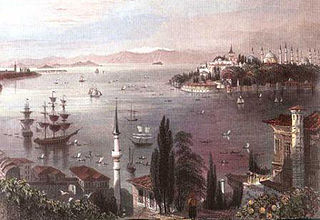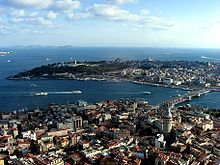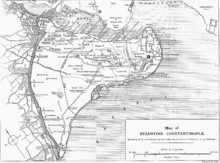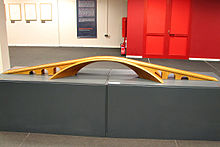- Golden Horn
-
For other uses, see Golden Horn (disambiguation).
 Seraglio Point from Pera, with the Bosphorus (left), the entrance of the Golden Horn (center and right), and the Sea of Marmara (distance) with the Princes' Islands on the horizon.
Seraglio Point from Pera, with the Bosphorus (left), the entrance of the Golden Horn (center and right), and the Sea of Marmara (distance) with the Princes' Islands on the horizon.
 Seraglio Point (Sarayburnu) at the entrance of the Golden Horn, as seen from the Galata Tower.
Seraglio Point (Sarayburnu) at the entrance of the Golden Horn, as seen from the Galata Tower.
 View of the Golden Horn (Turkish: Haliç) and the historic peninsula of Istanbul in the background, with Galata and Beyoğlu in the foreground. The Sea of Marmara and the Princes' Islands are seen behind the historic peninsula, towards the horizon.
View of the Golden Horn (Turkish: Haliç) and the historic peninsula of Istanbul in the background, with Galata and Beyoğlu in the foreground. The Sea of Marmara and the Princes' Islands are seen behind the historic peninsula, towards the horizon.
The Golden Horn (Turkish: Haliç (which is derived from the Arabic word Khaleej, meaning Gulf) or Altın Boynuz (literally "Golden Horn" in Turkish); Greek: Κεράτιος Κόλπος, Keratios Kolpos) is a historic inlet of the Bosphorus dividing the city of Istanbul and forming the natural harbor that has sheltered Greek, Roman, Byzantine, Ottoman and other ships for thousands of years. It is a scimitar-shaped estuary that joins the Bosphorus just at the point where that strait enters the Sea of Marmara, thus forming a peninsula the tip of which is "Old Istanbul" (ancient Byzantion and Constantinople). Its Greek and English names mean the same, but the significance of the designation "golden" is obscure, while its Turkish name Haliç simply means "estuary". It has witnessed many tumultuous historical incidents and its dramatic vistas have been the subject of countless works of art.
Contents
Description
The Golden Horn is a flooded prehistoric estuary. It is 7.5 kilometers long and, at its widest, 750 meters across. Its maximum depth, where it flows into the Bosphorus, is about 35 meters. It is today spanned by four bridges. They are, moving downstream, the Haliç Bridge (literally Golden Horn Bridge); the Eski Galata Bridge (literally Old Galata Bridge, as the former Galata Bridge was moved here in pieces, re-assembled and restored after a fire in 1992 damaged it; the current Galata Bridge which replaced it was completed in 1994); the Atatürk (Unkapanı) Bridge; and the Galata Bridge. A fifth bridge is currently under construction to connect the subway lines of the Istanbul Metro to the north and south of the Golden Horn.[1]
History
The Golden Horn (Keras) forms a deep natural harbor for the peninsula it encloses together with the Sea of Marmara. The Byzantine Empire had its naval headquarters there, and walls were built along the shoreline to protect the city of Constantinople from naval attacks. At the entrance to the Horn, there was a large chain pulled across from Constantinople to the old Tower of Galata (which was known as the Megàlos Pyrgos (meaning "Great Tower" in Greek, among the Byzantines) on the northern side, preventing unwanted ships from entering. This tower was largely destroyed by the Latin Crusaders during the Fourth Crusade (1204), but the Genoese built a new tower nearby, the famous Galata Tower (1348) which they called Christea Turris (Tower of Christ).
There were three notable times when the chain across the Horn was either broken or circumvented. In the 10th century the Kievan Rus' dragged their longships out of the Bosporus, around Galata, and relaunched them in the Horn; the Byzantines defeated them with Greek fire. In 1204, during the Fourth Crusade, Venetian ships were able to break the chain with a ram. In 1453, Ottoman Sultan Mehmed II, having failed in his attempt to break the chain with brute force, instead used the same tactic as the Rus', towing his ships across Galata into the estuary over greased logs.
After the conquest of Constantinople in 1453, Mehmed II resettled ethnic Greeks along the Horn in the Phanar (today's Fener), while Balat continued to be inhabited by Jews, as during the byzantine age. Today the Golden Horn is settled on both sides, and there are parks along each shore. The Istanbul Chamber of Commerce is also located along the shore, as are Muslim, Jewish and Christian cemeteries. The Galata Bridge connects the neighborhoods of Karaköy (the ancient Galata) and Eminönü. Until the 1980s the Horn was polluted with industrial waste, but it has since been cleaned up.[2] Today its history and beauty make it a popular tourist attraction in Istanbul.
Panoramic view of the outlet of the Golden Horn in Istanbul, as seen from the Galata Tower. The Galata Bridge can be seen in the center of the picture. The Seraglio Point (Sarayburnu) where the Topkapı Palace is located is seen at the left tip of the historic peninsula; followed by (left to right) the Hagia Sophia, the Sultan Ahmed (Blue) Mosque, the Yeni (New) Mosque near the Galata Bridge, the Beyazıt Tower rising high in the background, and the Süleymaniye (Suleiman the Magnificent) Mosque at far right, among others. The Sea of Marmara and the Princes' Islands are seen in the background, on the horizon. At the extreme left of the picture, the district of Kadıköy (ancient Chalcedon) on the Asian side of the city can be seen. Behind the Galata Bridge, towards the horizon, the Column of Constantine (which was surrounded by iron bars for restoration at the time of this photo) rises.
Leonardo's bridge
 Golden Horn Bridge designed by Leonardo da Vinci in 1502.
Golden Horn Bridge designed by Leonardo da Vinci in 1502.
In 1502 Leonardo da Vinci produced a drawing of a single span 240-metre (790 ft) bridge over the Horn as part of a civil engineering project for Sultan Bayezid II. The vision was resurrected in 2001 when a small footbridge of Leonardo's design was constructed near Ås in Norway.
Literature
The Golden Horn features in many works of literature dealing with classical themes. For example, G. K. Chesterton's poem Lepanto contains the memorable couplet "From evening isles fantastical rings faint the Spanish gun, And the Lord upon the Golden Horn is laughing in the sun".
See also
References
External links
- Golden Horn
- Golden Horn University
- The Social Community of Golden Horn
- The Leonardo Bridge Project
- Instanbul ferries
Coordinates: 41°01′45″N 28°57′40″E / 41.02917°N 28.96111°E
Categories:- Golden Horn
- Constantinople
- Estuaries of Turkey
- Ancient Greek geography
- Ports and harbours of Turkey
- Fatih, Istanbul
Wikimedia Foundation. 2010.






